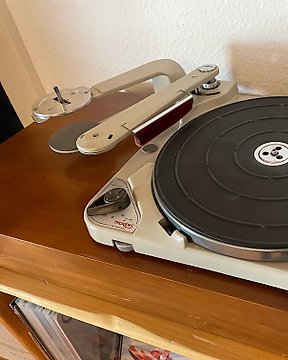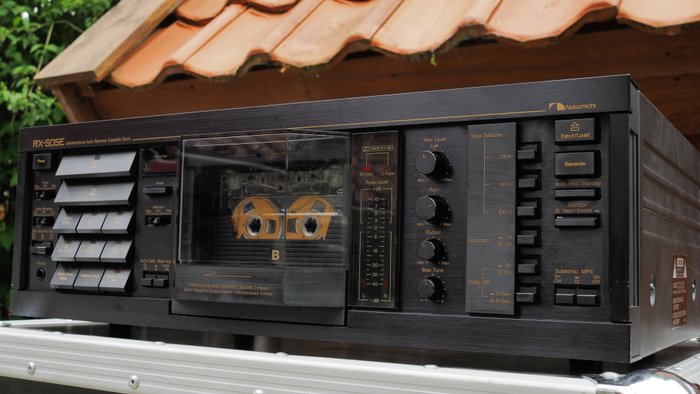
Thorens - TD-224 - 3-Speed Idler-Drive Record changer - Turntable
Nr. 18659917

Nr. 18659917

Contents of the auction:
Nakamichi RX-505E
with
Manual, service manual, various Nakamichi brochures from the time, scans of test messages in Audio and STEREO 1984/10 1986/12 as well as all photos on CD-Rom.
In the early 1980s at the time of the rise of auto-reverse (the tape plays in both directions), Nakamichi recognized that the angle of the band that runs over the display head does not remain the same when it is played in the opposite direction.
At tape recorders a tone head was just added (or sometimes even 2) but with a cassette deck there’s no space.
The first approach to follow the azimuth on the band itself, was to move the head a little.
A very complex matter that led to the design of the Nakamichi Dragon with its NAAC (Nakamichi Automatic Azimuth Correction).
After the Dragon Nakamichi let go of this approach (as very vulnerable and disturbance sensitive) and put his engineers to work to a more elegant solution.
The solution (considered by some as a gimmick) was to manually turn over the tape.
To maintain the correct alignment of the tone head the cassette is ejected, turned around and reloaded.
The result is the UDAR mechanism, (Uni Directional Car Reverse), a mechanical system that ejects the tape, turns it and loads it again in the deck.
It was available on all Nakamichi RX-series tape decks, meaning the RX-202, RX-303 and RX-505.
The RX series is no compromise, as many assumed, but the very best method to sustain the azimuth without using the expensive, complex and fragile NAAC-system.
The “top of the line” RX-505 is a later design than the Dragon an example of user friendliness.
The operation is elegant and simple.
The deck is easily set to the right values.
Compared to the Dragon it also has a updated and easier drive system and quieter electronics.
This running gear also forms the base for the Nakamichi 1000 that recorder from 1988.
The RX-505 is built from 1984 to 1993
The difference between the 505 and the 505E is not really clear to me.
To the eye there is no difference.
The German STEREO test in edition 1984/10 an RX-505 and their countrymen in of audio treated in 1986/12 an RX-505E.
The results are similar.
Both sheets boast the dynamic range and the low-noise electronics.
Specifications:
- 3 heads deck
- Dual capstan drive (capstans and headlines are at the top, the cassette
is placed upside down).
- 20 - 20.000 Hz.
- Dolby B and C
- Signal/noise ratio 70 dB.
- Synchronisation discrepancy;< 0.04 %
- 4 motors; 1 for express forwarding, 1 for playing and 2 for
turning it around.
- Dimensions: 45 x 15 x 30 cm.
- Weight: 10 kg
- Year of construction 1992 (this is the latest E-series)
The Nakamichi was mostly used in the display case and has withstood the years.
It is a very sought after vintage-audio item.
There are 2 light signs of wear that I have tried to depict in the best possible way with a macro lens.
Photo 9, 10, 11 and 12 show that on the Play button on the right side there’s a round little reddish stain.
I don't know what it is, have always left it and no cleaning attempts were made.
Note that on many other photos of this key the spot is not visible.
The same goes for the scratch on the "tape selector" panel at the height of EX (I) see photo 13, 14, 15 and 16.
All vintage audio equipment offered by me is professionally checked and tested before taking pictures.
The Nakamichi will be very carefully packaged (boxed twice) and sent worldwide.
In consultation it's possible to ship the vulnerable device in an appropriate flight-case (49, 50 and 51, see photos).
The buyer must then send it back.
I normally only do this with record players but for the RX-505E I will make an exception.
So kaufen Sie auf Catawiki
1. Etwas Besonderes entdecken
2. Höchstgebot abgeben
3. Sichere Zahlung durchführen